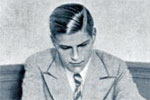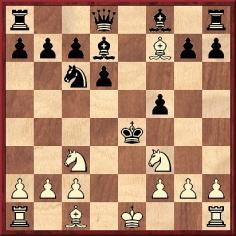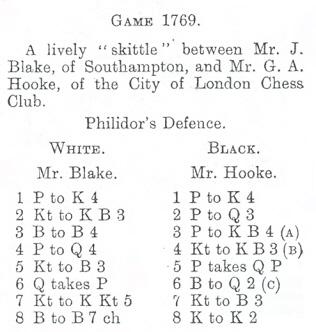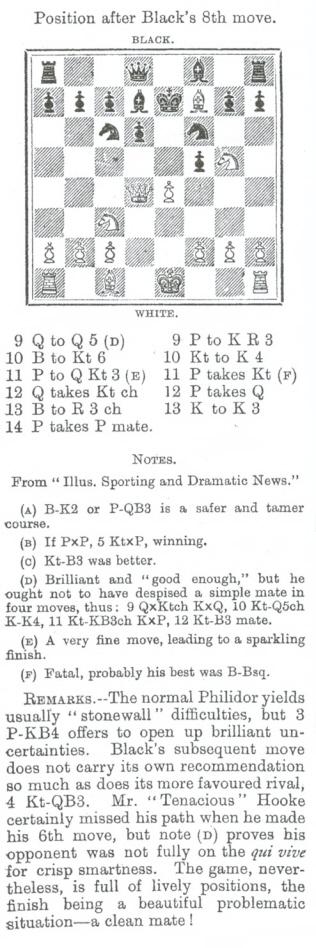Chess Explorations (30)
By Edward Winter
C.N. 5783 quoted from page vii of One Move and You’re Dead by
Erwin Brecher and Leonard Barden (London, 2007), which recorded that Barden
(one of the world’s most eminent chess journalists) ...
‘... was the first to predict in print that Garry Kasparov (then 11)
would become world champion and that Nigel Short (then nine) would become
Kasparov’s challenger.’
Regarding the Kasparov forecast, we were permitted by the Guardian Research
Department to reproduce the column in question (The Guardian, 24 February
1975, page 16):
In C.N. 507, after the prediction’s appearance on pages 5-6 of the book
on Kasparov Fighting Chess (London, 1983), we described it as ‘an
amazing piece of talent-spotting’. Fighting Chess called the passage
‘the first western report’ on Kasparov.
Further to the remarks about English players in the above Guardian column,
Mr Barden informed us in C.N. 5783:
‘My comment that “England, too, has some possible world class
prospects” was a reference to both Julian Hodgson and Nigel Short. It
was not until March-April 1975, after Short had performed impressively in
Jersey and in a junior event in London, that I rated him ahead of Hodgson,
allowing for age, and as a potential rival for Garry Kasparov. At the end
of the London event I asked Čenĕk Kottnauer, whose opinion on juniors
I regarded highly, to analyse and play a game with Short, and Kottnauer was
greatly impressed.
The invitation to the Soviet Embassy for Weinstein to play was on my prompting,
my grounds being that he would be nervous on his first journey to the West
and that Hodgson could gain a psychological edge for battles to come. Moscow
refused.
My forecast in the Guardian of 24 February 1975 was made about
15 months before Botvinnik went into print with his famous remark about the
future of chess being in Kasparov’s hands.’
Dominique Thimognier (St Cyr sur Loire, France) presented in C.N. 5846 this
bizarre cutting from Le Figaro of 3 December 1927:
For reasons unexplained, the French newspaper reported that the new world champion,
Alekhine, had just been sent a first challenge for his title, by the English
player C.A.S. Damant.
Further to our feature article Alfred
Kreymborg and Chess Jim Kulbacki (Cheyenne, WY, USA) drew attention in C.N.
6348 to two other chess-related poems by Kreymborg, one of them being ‘Chess
Players’ on pages 120-124 of Blood of Things (New York, 1920).
We find it especially intriguing for two apparently prescient references to
a player named Lilienthal. Here, for example, are the last few lines of the
poem:
At that time, of course, Andor Lilienthal (born 1911) was unknown to the chess
world.
The portrait of Lilienthal below comes from opposite page 32 of El Ajedrez
Español, October 1934:
As pointed out in C.N. 5217, a game-score often wrongly disseminated is ‘Blake
v Hooke, London, 1891’: 1 e4 e5 2 Nf3 d6 3 Bc4 f5 4 d4 Nf6 5 Nc3 exd4
6 Qxd4 Bd7 7 Ng5 Nc6 8 Bf7+ Ke7 9 Qxf6+ Kxf6 10 Nd5+ Ke5 11 Nf3+ Kxe4 12 Nc3
mate.
We noted that the game continues to be handled carelessly even by writers who
are aware that it was long ago shown to be spurious. For instance, on pages
90-91 of Chess Lists (Jefferson, 2002) A. Soltis wrote:
‘This version [i.e. ending with 12 Nc3 mate] appeared, for example,
in Chess Sparks [by J.H. Ellis], published in 1895. [Ellis’ book
merely stated after 7...Nc6 ‘and White gives mate in five moves’.]
It was repeated in Julius du Mont’s 200 Miniatures [200 Miniature
Games of Chess] but with the dateline of “London 1923”.
More serious, however, is the discrepancy that occurred when the game appeared
in the British Chess Magazine in 1930. There, after Black’s seventh
move, lies the note: “At this point there is [was] a mate in five which
White overlooked.” Instead, White played a different line but still
managed to sacrifice his queen, according to BCM: 9 Qd5 h6 10 Bg6 Ne5
11 b3! hxg5 12 Qxe5+! dxe5 13 Ba3+ Ke6 14 exf5 mate.
Which should you believe? The 1930 one. BCM’s editor then would
have known which was correct. The editor was Joseph Henry Blake. [The Editor
was R.C. Griffith, and in the 1930 BCM the game was given in an article
by A. Firth.]’
Beyond Soltis’ panoply of imprecision (he also put ‘Hook’
instead of Hooke), it is notable that he lifted all the research material, without
a word of credit, from the BCM’s Quotes and Queries column (the
game having been discussed in items 417, 1457, 3967 and 4078).
Even so, Soltis (who dated the game 1891) missed the last of those four items,
where Frank Skoff pointed out this feature on page 427 of the November 1889
BCM:
However, we added in C.N. 5217 that the game was played even earlier than 1889.
It was published on pages 286-287 of the Chess Player’s Chronicle,
17 October 1888, taken from G.A. MacDonnell’s column in the Illustrated
Sporting and Dramatic News:
Christian Sánchez (Rosario, Argentina) wrote in C.N. 5224:
‘Has someone else played the “spurious” game 1 e4 e5
2 Nf3 d6 3 Bc4 f5 4 d4 Nf6 5 Nc3 exd4 6 Qxd4 Bd7 7 Ng5 Nc6 8 Bf7+ Ke7 9 Qxf6+
Kxf6 10 Nd5+ Ke5 11 Nf3+ Kxe4 12 Nc3 mate?
Roberto Grau gives the same game-score but without names on page 80 of
volume I of Tratado general de ajedrez (Buenos Aires, 1939), and the
position after 7...Nc6 with the heading “M. Seguin-X” on page
122 of the same volume. The solution is on page 221.
Kurt Richter gives the game on page 140 of Hohe Schule der Schach
Taktik (Berlin, 1956) with the heading “Seguin-N.N., 1938”.’
To date, no further information has come to light.
Submit information
or suggestions on chess explorations
All ChessBase articles
by Edward Winter
 Edward
Winter is the editor of Chess
Notes, which was founded in January 1982 as "a forum for aficionados
to discuss all matters relating to the Royal Pastime". Since then, over 6,300
items have been published, and the series has resulted in four books by Winter:
Chess
Explorations (1996), Kings,
Commoners and Knaves (1999), A
Chess Omnibus (2003) and Chess
Facts and Fables (2006). He is also the author of a monograph
on Capablanca (1989).
Edward
Winter is the editor of Chess
Notes, which was founded in January 1982 as "a forum for aficionados
to discuss all matters relating to the Royal Pastime". Since then, over 6,300
items have been published, and the series has resulted in four books by Winter:
Chess
Explorations (1996), Kings,
Commoners and Knaves (1999), A
Chess Omnibus (2003) and Chess
Facts and Fables (2006). He is also the author of a monograph
on Capablanca (1989).
Chess Notes is well known for its historical research, and anyone browsing
in its archives
will find a wealth of unknown games, accounts of historical mysteries, quotes
and quips, and other material of every kind imaginable. Correspondents from
around the world contribute items, and they include not only "ordinary readers"
but also some eminent historians – and, indeed, some eminent masters. Chess
Notes is located at the Chess
History Center. Signed copies of Edward Winter's publications are
currently available.


























 Edward
Winter is the editor of
Edward
Winter is the editor of 




